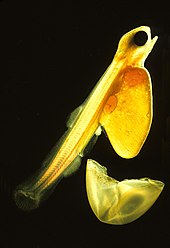Atlantic Salmon
Salmon are fish that belong to the family of Salmonidae (biologists classify types of organisms according to similar characteristics: the term “families” encompasses the more commonly used terms “genus” and “species.” Within the Salmonidae family are the genus Salmo, which contains Atlantic salmon, and the genus Oncorhynchus, which contains Pacific salmon released into the Great Lakes, trout, and char. A common characteristic of salmonids is the presence of an adipose fin just in front of the tail on the dorsal (top) side. In general, these are all bony fish that are caught commercially from the wild, a dietary mainstay of aboriginal populations, sought after by recreational anglers, and farmed intensively because of their desirable taste and nutritional characteristics. Atlantic salmon, Salmo salar (salmon, the leaper) is native to the North Atlantic, and is generally recognized to consist of three populations: North American, European, and Baltic. Atlantic salmon change their appearance during their life cycles, but in general have an elongated shape and silvery color. As adults at sea, which is how we often think of schools of salmon, they have small scales, with silvery flanks and a white belly. As adults become sexually mature and migrate to fresh water, their color changes, becoming greenish or brown, and red or orange mottled. The males develop an exaggeratedly hooked lower jaw, and a staggered line of teeth














No comments:
Post a Comment